Coloring Pages
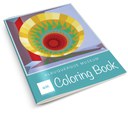 Choose Your Favorite Picture
Choose Your Favorite Picture
Tom Palmore, Survivor
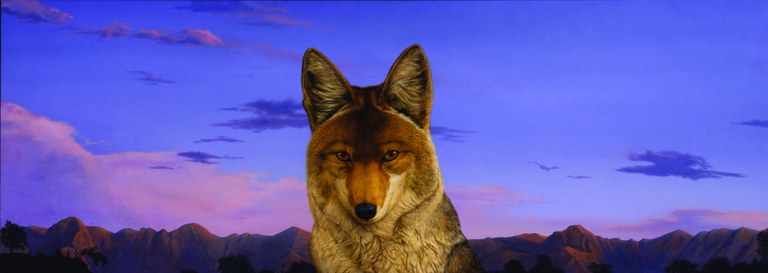
Tom Palmore, Survivor, 1995, oil on canvas, Albuquerque Museum, museum purchase, 1993 General Obligation Bonds
One of the most popular works in the Museum’s collection, Survivor is a fine example of Tom Palmore’s well-known animal portraits. Palmore creates very realistic, large paintings of animals that show the subject in meticulous detail; they often have dramatic backgrounds that help to make the animal subject stand out.
Survivor features the coyote, which is one of the most iconic animals of the American Southwest. Coyotes are known in many Dine and Pueblo stories for their sneakiness, stubbornness, and smarts. Palmore shows us the coyote as a wise watcher, reminding us that we are part of the natural world even in the midst of the urban city.
Ed Garman, Painting #231
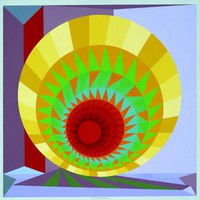
Ed Garman, Painting #231, 1941, oil on panel, Albuquerque Museum, gift of Trell Garman
While working as an archaeologist cleaning Pueblo Indian potsherds, Ed Garman became fascinated with the geometric designs found on the broken pottery. These designs inspired Garman to experiment with making paintings that highlighted geometric shapes, crisp lines, and bright colors. He combined these three elements to give his work a sense of movement that draws the viewer into the painting.
Painting #231 uses a combination of triangles, circles, rectangles, and bright colors to make the artwork seem as if it is moving as you look at it. What colors will you use in your version of Painting #231 to make it look as if it is moving?
Tony Price, Atomic Thunderbird
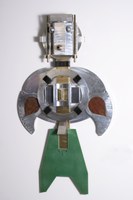
Tony Price, Atomic Thunderbird, 1994, cut and assembled stainless steel, bronze, plastic, fiberglass and mixed media, Albuquerque Museum, museum purchase, 1993 General Obligation Bonds
Artist Tony Price was eight years old when the first atomic bomb was tested in New Mexico in 1945. This event motivated Price to educate people about the impact of nuclear weapons and their devastating potential. In the 1960s Price began his series of Atomic Art using leftover parts from Los Alamos National Lab to create sculptures based on Hopi kachinas. These pieces transform the negative energy of nuclear bombs through the positive forces of spirituality, humor, and art.
In Native American stories, thunderbirds are large birds whose wing flaps sound like thunder and who bring storms with them wherever they go. These storms are good when they bring much-needed rain for crops, and bad when the rain comes with destructive winds, floods, and fires caused by lighting. Atomic Thunderbird represents both the good and bad sides of nuclear science. While nuclear weapons can cause great destruction, people also use nuclear substances to make energy for electricity and in medicine to heal people.
Download Coloring PageAndrew Dasburg, Red Tulips
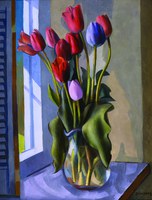
Andrew Dasburg, Red Tulips, 20th century, oil on canvas, collection of Albuquerque Museum Foundation, gift of Constance Modral
A still life is a work of art that shows a group of inanimate objects like fruit, flowers, or household items. During the 1920s, artist Andrew Dasburg painted many floral and fruit still lifes, using them to explore elements of art like shape, color, and line in his work.
In his painting Red Tulips, Dasburg staged a vase of flowers in a window sill in front of a plain background. He shows movement in the painting with the upward sweep of the tulips, the curved petals, and the ripple of the green leaves. The red flowers stand out against the muted colors seen in the rest of the painting. The flowers bend toward the light shining through the window, suggesting that they are full of life.
Download Coloring PageRoute 66 Sign
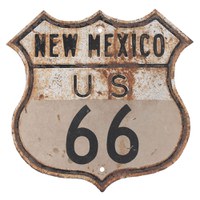
Route 66 Sign, 1940-1950, steel, paint, reflective coating, 16 x 17 x 3/8 in., Albuquerque Museum, museum purchase, Special Revenue Fund
In 1925, the federal highway system began giving numbers to the quickly growing number of interstate roads. Roads that traveled east-west were given even numbers, and north-south routes received odd numbers. The number 66 was assigned to the road that ran through Albuquerque as it went from Chicago to Los Angeles. The road became famous because of pop culture references like the song “Get Your Kicks on Route 66” and John Steinbeck’s famous novel The Grapes of Wrath.
Each state was responsible for the production and maintenance of US route signs, and several versions of New Mexico’s Route 66 sign have existed over the years. This sign was posted somewhere between Glenrio and Manuelito, New Mexico, in the 1940s.
Download Coloring PageNuestra Señora de los Dolores
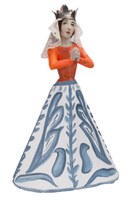
Doña Attributed to Antonio Molleno, The School of Antonio Molleno, or the Truchas Master Bulto, Nuestra Señora de los Dolores / Our Lady of Sorrows, 1800-45, wood, gesso, canvas, natural pigments, Albuquerque Museum, Gift of John Borradaile Colligan
A Bulto is a popular form of traditional Hispanic art that is still made in New Mexico today. It is a statue of a Catholic saint that is carved from wood, painted, and sometimes clothed in fabric. This bulto represents Nuestra Señora de los Dolores, also known as Our Lady of Sorrows, which shows the Virgin Mary in relation to the seven major sorrows of her life. Our Lady of Sorrows is very important in the Catholic religion, and many churches have works of art showing her.
Nuestra Señora de los Dolores originally came from San Filipe de Neri Church, which is located in Albuquerque’s Old Town.
Download Coloring Page
Repostero
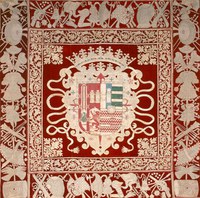
Messina, Sicily, Repostero, 1620–40, silk, linen, metallic threads, 142 x 142 in., Albuquerque Museum, gift of the 18th Duke (Don Beltrán Osorio y Diez de Rivera) and Duchess of Alburquerque, Spain, via the City of Albuquerque Public Art Program
The coat of arms featured on this coloring sheet is from the center of a repostero, or heraldic tapestry, of the Cueva family. This is the family that held the title of the Duke of Alburquerque from 1464 through now. This particular tapestry belonged to Francisco Fernández de la Cueva, 8th Duke of Alburquerque, who was the Viceroy of New Spain.
The repostero coat of arms contains emblems representing the duke's family. They include a dragon, which is based on a family legend of an ancestor who slew a dragon in a cave, and a lion, which is a symbol for courage and royalty. The 18th Duke of Alburquerque, Spain, presented the repostero to the people of Albuquerque during the 1956 Enchantorama celebrating our city's 250th anniversary.
Download Coloring PageNampeyo, Bowl
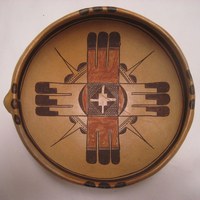
Nampeyo, Hopi-Tewa, Bowl, 1905–07, natural clay and paint, 3 3/16 x 9 6/15 in., Museum purchase, Four Centuries Bond Fund
Nampeyo was a famous Hopi-Tewa potter from the Hopi Reservation in Arizona. She based many of the designs she painted on her pottery on what she saw painted on ancient pottery sherds that were found on the Hopi Reservation. She eventually developed her own style based on these designs that was called “Hopi Revival.”
Nampeyo made this beautiful bowl while working as an artist-demonstrator at Hopi House, which was located at the Grand Canyon in Arizona, from 1905 to 1907. The interior shows Nampeyo's Quartered Eagle design, which features a repeating motif of eagle feathers.
Download Coloring Page
